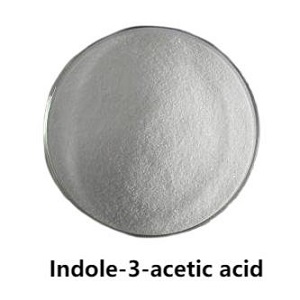Best Prices Plant Hormone Indole-3-Acetic Acid Iaa
Nature
Indoleacetic acid is an organic substance. Pure products are colorless leaf crystals or crystalline powders. It turns rosy when exposed to light. Melting point 165-166℃(168-170℃). Soluble in anhydrous ethanol, ethyl acetate, dichloroethane, soluble in ether and acetone. Insoluble in benzene, toluene, gasoline and chloroform. Insoluble in water, its aqueous solution can be decomposed by ultraviolet light, but is stable to visible light. The sodium salt and potassium salt are more stable than the acid itself and are easily soluble in water. Easily decarboxylated to 3-methylindole (skatine). It has a duality to plant growth, and different parts of the plant have different sensitivity to it, generally the root is larger than the bud is larger than the stem. Different plants have different sensitivity to it.
Preparation method
3-indole acetonitrile is formed by the reaction of indole, formaldehyde and potassium cyanide at 150℃, 0.9~1MPa, and then hydrolyzed by potassium hydroxide. Or by the reaction of indole with glycolic acid. In a 3L stainless steel autoclave, 270g(4.1mol)85% potassium hydroxide, 351g(3mol) indole were added, and then 360g(3.3mol)70% hydroxy acetic acid aqueous solution was slowly added. Closed heating to 250℃, stirring for 18h. Cool to below 50℃, add 500ml water, and stir at 100℃ for 30min to dissolve potassium indole-3-acetate. Cool to 25℃, pour the autoclave material into water, and add water until the total volume is 3L. The aqueous layer was extracted with 500ml ethyl ether, acidified with hydrochloric acid at 20-30℃, and precipitated with indole-3-acetic acid. Filter, wash in cold water, dry away from light, product 455-490g.
Biochemical significance
Property
Easily decomposed in light and air, not durable storage. Safe for people and animals. Soluble in hot water, ethanol, acetone, ether and ethyl acetate, slightly soluble in water, benzene, chloroform; It is stable in alkaline solution and is first dissolved in a small amount of 95% alcohol and then dissolved in water to an appropriate amount when prepared with pure product crystallization.
Use
Used as plant growth stimulant and analytical reagent. 3-indole acetic acid and other auxin substances such as 3-indole acetaldehyde, 3-indole acetonitrile and ascorbic acid exist naturally in nature. The precursor of 3-indole acetic acid biosynthesis in plants is tryptophan. The basic role of auxin is to regulate plant growth, not only to promote growth, but also to inhibit growth and organ building. Auxin not only exists in free state in plant cells, but also exists in bound auxin which is strongly bound to biopolymeric acid, etc. Auxin also forms conjugations with special substances, such as indole-acetyl asparagine, apentose indole-acetyl glucose, etc. This may be a storage method of auxin in the cell, and also a detoxification method to remove the toxicity of excess auxin.
Effect
Plant auxin. The most common natural growth hormone in plants is indoleacetic acid. Indoleacetic acid can promote the formation of the top bud end of plant shoots, shoots, seedlings, etc. Its precursor is tryptophan. Indoleacetic acid is a plant growth hormone. Somatin has many physiological effects, which are related to its concentration. Low concentration can promote growth, high concentration will inhibit growth and even make the plant die, this inhibition is related to whether it can induce the formation of ethylene. The physiological effects of auxin are manifested on two levels. At the cellular level, auxin can stimulate cambium cell division; Stimulating branch cell elongation and inhibiting root cell growth; Promote xylem and phloem cell differentiation, promote hair cutting roots and regulate callus morphogenesis. At the organ and whole plant level, auxin acts from seedling to fruit maturity. Auxin controlled seedling mesocotyl elongation with reversible red light inhibition; When the indoleacetic acid is transferred to the lower side of the branch, the branch will produce geotropism. Phototropism occurs when indoleacetic acid is transferred to the backlit side of the branches. Indoleacetic acid caused apex dominance. Delay leaf senescence; Auxin applied to leaves inhibited abscission, while auxin applied to the proximal end of the abscission promoted abscission. Auxin promotes flowering, induces parthenocarpy development, and delays fruit ripening.
Apply
Indoleacetic acid has a wide spectrum and many uses, but it is not commonly used because it is easy to degrade in and out of plants. In the early stage, it was used to induce parthenocarpous and fruit-setting of tomatoes. In the blooming stage, the flowers were soaked with 3000 mg/l liquid to form seedless tomato fruit and improve fruit setting rate. One of the earliest uses was to promote the rooting of cuttings. Soaking the base of cuttings with 100 to 1000 mg/l of medicinal solution can promote the formation of adventitious roots of tea tree, gum tree, oak tree, metasequoia, pepper and other crops, and accelerate the rate of nutritional reproduction. 1~10 mg/l indoleacetic acid and 10 mg/L oxamyline were used to promote rooting of rice seedlings. 25 to 400 mg/l of liquid spray chrysanthemum once (in 9 hours of photoperiod), can inhibit the emergence of flower buds, delay flowering. Growing in the long sunshine to 10 -5 mol/l concentration sprayed once, can increase female flowers. Treating beet seeds promotes germination and increases root tuber yield and sugar content.
Introduction to auxin
Introduction
Auxin (auxin) is a class of endogenous hormones containing an unsaturated aromatic ring and an acetic acid side chain, English abbreviation IAA, the international common, is indole acetic acid (IAA). In 1934, Guo Ge et al. identified it as indole acetic acid, so it is customary to often use indole acetic acid as a synonym for auxin. Auxin is synthesized in the extended young leaves and apical meristem, and is accumulated from top to base by long-distance transport of phloem. The roots also produce auxin, which is transported from the bottom up. Auxin in plants is formed from tryptophan through a series of intermediates. The main route is through indoleacetaldehyde. Indole acetaldehyde can be formed by the oxidation and deamination of tryptophan to indole pyruvate and then decarboxylated, or it can be formed by the oxidation and deamination of tryptophan to tryptamine. The indole acetaldehyde is then reoxidized to indole acetic acid. Another possible synthetic route is the conversion of tryptophan from indole acetonitrile to indole acetic acid. Indoleacetic acid can be inactivated by binding with aspartic acid to indoleacetylaspartic acid, inositol to indoleacetic acid to inositol, glucose to glucoside, and protein to indoleacetic acid-protein complex in plants. Bound indoleacetic acid usually accounts for 50-90% of indoleacetic acid in plants, which may be a storage form of auxin in plant tissues. Indoleacetic acid can be decomposed by oxidation of indoleacetic acid, which is common in plant tissues. Auxins have many physiological effects, which are related to their concentration. Low concentration can promote growth, high concentration will inhibit growth and even make the plant die, this inhibition is related to whether it can induce the formation of ethylene. The physiological effects of auxin are manifested on two levels. At the cellular level, auxin can stimulate cambium cell division; Stimulating branch cell elongation and inhibiting root cell growth; Promote xylem and phloem cell differentiation, promote hair cutting roots and regulate callus morphogenesis. At the organ and whole plant level, auxin acts from seedling to fruit maturity. Auxin controlled seedling mesocotyl elongation with reversible red light inhibition; When the indoleacetic acid is transferred to the lower side of the branch, the branch will produce geotropism. Phototropism occurs when indoleacetic acid is transferred to the backlit side of the branches. Indoleacetic acid caused apex dominance. Delay leaf senescence; Auxin applied to leaves inhibited abscission, while auxin applied to the proximal end of the abscission promoted abscission. Auxin promotes flowering, induces parthenocarpy development, and delays fruit ripening. Someone came up with the concept of hormone receptors. A hormone receptor is a large molecular cell component that binds specifically to the corresponding hormone and then initiates a series of reactions. The complex of indoleacetic acid and receptor has two effects: first, it acts on membrane proteins, affecting medium acidification, ion pump transport and tension change, which is a fast reaction (< 10 minutes); The second is to act on nucleic acids, causing cell wall changes and protein synthesis, which is a slow reaction (10 minutes). Medium acidification is an important condition for cell growth. Indoleacetic acid can activate the ATP(adenosine triphosphate) enzyme on the plasma membrane, stimulate hydrogen ions to flow out of the cell, reduce the pH value of the medium, so that the enzyme is activated, hydrolyze the polysaccharide of the cell wall, so that the cell wall is softened and the cell is expanded. The administration of indoleacetic acid resulted in the appearance of specific messenger RNA (mRNA) sequences, which altered protein synthesis. Indoleacetic acid treatment also changed the elasticity of the cell wall, allowing cell growth to proceed. The growth promotion effect of auxin is mainly to promote the growth of cells, especially the elongation of cells, and has no effect on cell division. The part of the plant that feels the light stimulation is at the tip of the stem, but the bending part is at the lower part of the tip, which is because the cells below the tip are growing and expanding, and it is the most sensitive period to auxin, so the auxin has the greatest influence on its growth. Aging tissue growth hormone does not work. The reason why auxin can promote the development of fruits and the rooting of cuttings is that auxin can change the distribution of nutrients in the plant, and more nutrients are obtained in the part with rich auxin distribution, forming a distribution center. Auxin can induce the formation of seedless tomatoes because after treating unfertilized tomato buds with auxin, the ovary of the tomato bud becomes the distribution center of nutrients, and the nutrients produced by photosynthesis of the leaves are continuously transported to the ovary, and the ovary develops.
Generation, transportation and distribution
The main parts of auxin synthesis are meristant tissues, mainly young buds, leaves, and developing seeds. Auxin is distributed in all organs of the plant body, but it is relatively concentrated in the parts of vigorous growth, such as the coleopedia, buds, root apex meristem, cambium, developing seeds and fruits. There are three ways of auxin transport in plants: lateral transport, polar transport and non-polar transport. Lateral transport (backlight transport of auxin in the tip of the coleoptile caused by unilateral light, near-ground side transport of auxin in the roots and stems of plants when transverse). Polar transport (from the upper end of morphology to the lower end of morphology). Non-polar transport (in mature tissues, auxin can be non-polar transported through phloem).
The duality of physiological action
Lower concentration promotes growth, higher concentration inhibits growth. Different plant organs have different requirements for the optimal concentration of auxin. The optimum concentration was about 10E-10mol/L for roots, 10E-8mol/L for buds and 10E-5mol/L for stems. Auxin analogues (such as naphthalene acetic acid, 2, 4-D, etc.) are often used in production to regulate plant growth. For example, when bean sprouts are produced, the concentration suitable for stem growth is used to treat the bean sprouts. As a result, the roots and buds are inhibited, and the stems developed from the hypocotyl are very developed. The apex advantage of plant stem growth is determined by the transport characteristics of plants for auxin and the duality of auxin physiological effects. The apex bud of the plant stem is the most active part of auxin production, but the concentration of auxin produced at the apex bud is constantly transported to the stem through active transport, so the concentration of auxin in the apex bud itself is not high, while the concentration in the young stem is higher. It is most suitable for stem growth, but has an inhibitory effect on buds. The higher the concentration of auxin in the position closer to the top bud, the stronger the inhibitory effect on the side bud, which is why many tall plants form a pagoda shape. However, not all plants have a strong apex dominance, and some shrubs begin to degrade or even shrink after the development of the apex bud for a period of time, losing the original apex dominance, so the tree shape of the shrub is not a pagoda. Because high concentration of auxin has the effect of inhibiting plant growth, the production of high concentration of auxin analogues can also be used as herbicides, especially for dicotyledonous weeds.
Auxin analogues: NAA, 2, 4-D. Because auxin exists in small amounts in plants, and it is not easy to preserve. In order to regulate plant growth, through chemical synthesis, people have found auxin analogues, which have similar effects and can be mass-produced, and have been widely used in agricultural production. The effect of earth gravity on auxin distribution: the background growth of stems and the ground growth of roots are caused by the earth’s gravity, the reason is that the earth gravity causes the uneven distribution of auxin, which is more distributed in the near side of the stem and less distributed in the back side. Because the optimum concentration of auxin in stem was high, more auxin in the near side of stem promoted it, so the near side of stem grew faster than the back side, and kept the upward growth of stem. For roots, because the optimal concentration of auxin in roots is very low, more auxin near the ground side has an inhibitory effect on the growth of root cells, so the growth of near the ground side is slower than that of the back side, and the geotropic growth of roots is maintained. Without gravity, roots don’t necessarily grow down. The effect of weightlessness on plant growth: the root growth toward the ground and the stem growth away from the ground are induced by the earth’s gravity, which is caused by the uneven distribution of auxin under the induction of the earth’s gravity. In the weightless state of space, due to the loss of gravity, the growth of the stem will lose its backwardness, and the roots will also lose the characteristics of the ground growth. However, the apex advantage of stem growth still exists, and the polar transport of auxin is not affected by gravity.










